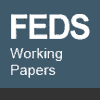
| Finance and Economics Discussion Series |
|---|
 |
Avoiding Nash Inflation: Bayesian and Robust Responses to Model Uncertainty Robert J. Tetlow and Peter von zur Muehlen 2002-9 |
Abstract: We examine learning, model misspecification, and robust policy responses to misspecification in a
quasi-real-time environment. The laboratory for the analysis is the Sargent (1999) explanation for
the origins of inflation in the 1970s and the subsequent disinflation. Three robust policy rules are
derived that differ according to the extent that misspecification is taken as a parametric phenomenon.
These responses to drifting estimated parameters and apparent misspecification are compared
to the certainty-equivalent case studied by Sargent. We find gains from utilizing robust
approaches to monetary policy design, but only when the approach to robustness is carefully tailored
to the problem at hand. In the least parametric approach, the medicine of robust control
turns out to be too potent for the disease of misspecification. In the most parametric approach, the
response to misspecification is too weak and too misdirected to be of help. But when the robust
approach to policy is narrowly directed in the correct location, it can avoid Nash inflation and
improve social welfare. It follows that agnosticism regarding the sources of misspecification has
its pitfalls. We also find that Sargent?s story for the rise of inflation of the 1970s and its subsequent
decline in the 1980s is robust to most
Full paper (452 KB PDF)
| Full paper (847 KB Postscript)
Home | FEDS | List of 2002 FEDS papers
Accessibility
To comment on this site, please fill out our feedback form.
Last update: June 6, 2003